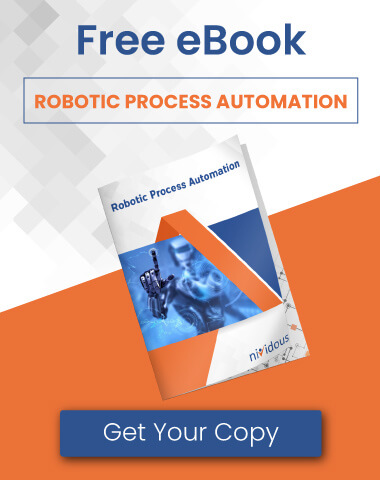This article will explain the difference between robotic process automation (RPA) and workflow automation. It will also show you how both technologies can help you streamline your business processes for more profits, better efficiency, and improved workforce productivity. The combination of the two technologies can help you achieve a lot more. As discovered by the Gartner team, if fully implemented, RPA can save upward of 25,000 hours per year and $878,000. Imagine what the impact can be if RPA is combined with workflow automation.
But before we dive into understanding both technologies, let’s briefly examine how they differ.
RPA vs. Workflow Automation
RPA and workflow automation help you automate tasks and processes to achieve better results. Though they accomplish similar functions, they operate at two very different levels. RPA is best used when you need to automate individual tasks that are manual, repetitive, and time-consuming in nature. In comparison, workflow automation is an approach to streamline and automate complete end-to-end business processes. Interestingly, RPA and workflow automation are complementary technologies allowing you to automate more and produce better business results when used together.
What is RPA?
RPA is a form of automation technology that uses software “bots” to perform tasks across multiple applications. This technology is used to automate mundane, repetitive tasks typically performed by humans. RPA bots interact with application user interfaces and can operate based on specified rules. RPA requires no coding or complex software configurations, making it easy and cost-effective to implement and maintain.
RPA is widely used across industries and business functions to reduce errors, produce results faster, and improve overall efficiency. However, RPA, paired with artificial intelligence (AI) technologies, is getting more traction for its ability to automate more complex tasks.
A real-world business use case: A leading manufacturing company‘s accounting and finance team used the Nividous platform to process a large influx of invoices automatically. By introducing RPA into the workflow, the company was able to cut down on human labor and increase accuracy while maintaining quality assurance standards. Nividous’ fully automated solution that includes native AI, RPA, and workflow automation capabilities seamlessly integrate with the back-end ERP system for automatic three-way matching between Invoice, PO, and GRN. The automation that used all three native automation capabilities helped their finance team improve the processes’ overall efficiency and make better-informed decisions regarding financial planning.
Key benefits of RPA include the following:
- Reduced costs and improved efficiency
- Increased accuracy and fewer errors
- Increased speed of operations and faster turnaround times
- Improved customer service and satisfaction
- Ability to automate complex processes with ease
- Reduced manual labor and increased employee productivity
- Streamlined compliance with regulatory requirements
Read this Blog to know more about benefits of RPA.
What is Workflow Automation?
Workflow Automation refers to designing, executing, and automating processes to optimize results. This approach centers around automating the sequence of tasks rather than individual components. Workflows are defined by logic and rules-based triggers that involve connecting human tasks, automated tasks, data, or files between people or systems. A workflow automation tool allows you to use a drag-and-drop interface to create a process flow based on set logic or rules. Automated workflow eliminates errors and irregularities associated with manual processes.
You can apply workflow automation to various business processes, including employee onboarding, customer onboarding, order processing, product delivery, and streamlining customer service inquiries.
Let’s understand how workflow automation can help with employee onboarding:
Employee onboarding is a time-consuming process involving contracts, introductions, training, and office supplies. However, when you automate these tasks by creating a standardized flow, the process gets done faster.
- All stakeholders have complete visibility into the process, making it easy to instantly access new candidates’ information when entered into the database.
- New hires automatically receive important documents before their start date.
- Automatically trigger the next steps in the onboarding process by assigning tasks and approvals during an employee’s first few weeks at work.
- Send automatic notifications to the hiring managers when candidates complete specific tasks or move to the next stage in the onboarding process, minimizing questions to HR.
Refer to this blog to understand how to incorporate workflow automation into your business.
RPA and Workflow Automation: How do They Work Together?
As per Gartner predictions, by 2024, 69% of work currently being done by managers will be fully automated. Undoubtedly, businesses are increasingly using automation technologies to realize their benefits.
A workflow automation tool eliminates communication breakdowns that lead to delays and errors. As processes are standardized and automated, employees can manage their work with little supervision.
However, suppose you deploy RPA bots to further automate the process by automating individual tasks within the workflow, such as data entry or invoice processing; you save more time and costs. RPA bots take only a fifth of the time humans spend to complete a task, and as a result, the freed-up employees can focus on more strategic work that requires human intelligence. Higher accuracy, increased productivity, fewer errors, and enhanced operational efficiency are expected benefits of RPA and workflow automation.
At Nividous, It is More Than Just RPA
We empower businesses to work at their peak efficiency by providing end-to-end process automation out of the box that can automate distinct tasks with RPA, complex jobs with AI, and complete workflows with workflow automation which is also known as business process management (BPM). This combination of technologies is often referred to as intelligent automation— and with the Nividous platform, you can control it all through a single easy-to-use interface.
Ready to discover more?
Request a demo today and learn how much time and money you can save with the Nividous’ intelligent automation platform.
Click any term below to learn more.
Intelligent Automation
The seamless integration of RPA, AI, and workflow automation tools to automate complex, end-to-end business processes for higher efficiency and agility.
RPA (Robotic Process Automation)
Software bots that replicate human actions to perform rule-based, repetitive tasks with speed and accuracy.
Agentic AI
An advanced form of AI that autonomously makes decisions and takes actions to achieve defined goals without human intervention.
Generative AI
AI models, such as ChatGPT and Gemini, that can create original content—text, images, or code—based on natural language prompts.
Low-Code Platform
A visual development environment that enables users to build applications quickly using drag-and-drop components and minimal coding.
Hyperautomation
A strategic approach that leverages multiple technologies—including RPA, AI, and low-code platforms—to automate business processes end-to-end across the enterprise.





